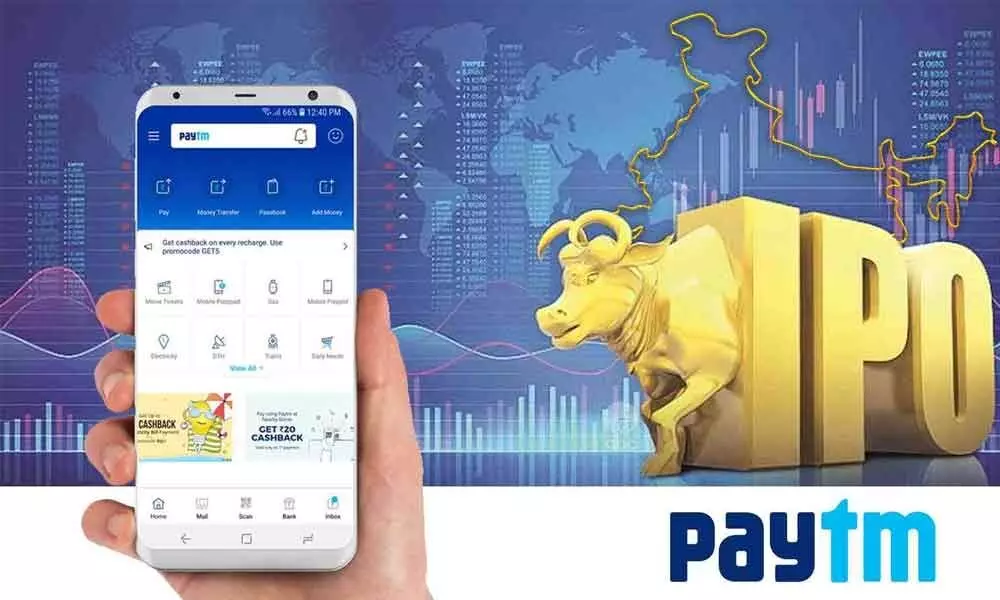Post-listing: Should you buy Paytm shares?
Investing in the shares of One 97 communications, parent company of Paytm, at Rs1,300-1,350 levels with a six month or longer period of investment would be rewarding for shareholders
image for illustrative purpose

One 97 Communications Limited, which owns the brand Paytm, has been listed on the bourses. The company had issued shares at the top end of the price band at Rs2,150 and saw its shares debut at the discovered price of Rs1,955. The share closed at Rs1,564.15, a loss of Rs 585.85 or 27.25 per cent. On NSE, the share closed at Rs 1,560.80. This issue was India's largest primary market issuance to date and therefore becomes that much more significant.
This is the poorest start that any company had on listing in a very long time and would be a setback for the existing companies already listed from the new age technology platforms. It would also affect companies from this space which are looking to tap the markets and primary market in general.
The purpose of this article is to look into the company and its business a little more closely and examine whether there is a business case to invest, and if so when. Paytm is India's most valuable payments brand and has brought half a billion Indians into mainstream economy through technology led financial services. It is the preferred mobile first digital payment platform and very significantly, the largest payment gateway aggregator.
In 2015, it was Paytm which pioneered QR code led payment for in-store merchants and today one can pay for almost anything through a QR code. It has more use cases like ticketing and bill payments. Since the last four years, Paytm payments bank has attained the largest scale having over 65 million accounts. Even more significantly it has helped in making the bottom of the pyramid merchants' part of the system and platform.
It is the largest issuer of Fast tags, used at toll plazas. A key differentiation for Paytm is the fact that every transaction done on the platform is without any charges payable to NPCI or UPI while Paytm earns a minimum of 50 paisa as it has its own system. This would be a big game changer going forward as the number of transactions continues to multiply on the platform. Further while no platform will ever stop growing, Paytm has reached a fairly mature status and going forward there would be incremental expenditure on upgrading and maintenance, not on creating a new platform.
Paytm being a bank and having access to credit card and prepaid debit cards, can use data for generating spends and earn revenues. It has a high base of active customers and there is virtually no cost incurred on such customers.
Its tie-up with HDFC Bank is a win-win situation for both of them and helps in generating revenues. Paytm is able to lend on its platform through its association with partner banks. It has no liabilities as the loans are not on its books and the company earns high margins on the amount of the short-term loans. They also similarly sell products like insurance where the platform is used and the customer chooses the insurance company. The issuance of the policy generates commission, the platform transaction generates revenue and so on.
Paytm Bank IPO in the near future would be another value unlocking opportunity for the company and its shareholders to benefit in the near term. It has a very active Paytm First Games platform which contributes significant revenues but are currently not consolidated. Paytm Money and Paytm Malls are yet another extension of the company's product offerings. They offer facilities for buying mutual funds, equity and F&O trading as well through the platform. There is a very interesting product which is very popular and is called 'Buy Now Pay Later'. This product assists lower income and the mid income segment to buy products when they so require. The loan is provided by partner banks and NBFC's while Paytm provides the facilitation and earns income.
This company looks like having better prospects. The next question that comes to mind is that if it has a great future, why the debacle? How much more can it fall? Simple answer is company was not understood and management was confident of the issue pulling through. While the issue did pull through, expectations of listing pop were not met. Going forward, in a worst-case scenario, the share price could fall another 12-15 per cent from Thursday's levels, not because the issue is expensive but because there is an overhang. With each passing day there could be more desperate sellers.
With expenses on advertising/cash back having been slashed and likely to be cut further, it would be a matter of time before the company turns cash positive as contribution profit and margins grow further. The company is witnessing strong momentum in business and transactions. Results for the September and December quarters would provide insights into actual workings or parameters discussed in the article. Looking at these factors, I believe investing in the share around the Rs 1300-1350 levels with a six month or longer period of investment would be rewarding for shareholders.
(The author is the founder of Kejriwal Research and Investment Services, an advisory firm)

